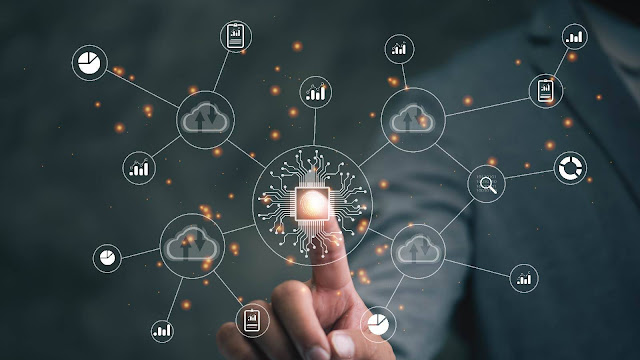Featured
- Get link
- X
- Other Apps
Industrial Robotic Advancements: Transforming the Business Landscape

Introduction
In recent years, the business sector has witnessed a
remarkable transformation driven by advancements in industrial robotics. These
sophisticated machines, once confined to manufacturing floors, are now
permeating various industries, revolutionizing processes, and redefining
efficiency standards. This thing explores the profound impact of industrial
robotic advancements on the business sector, delving into key technologies,
applications, challenges, and the future outlook. Read More: prohealthweb
I. Evolution of Industrial Robotics
A. Historical Context
The roots of industrial robotics can be traced back to the
mid-20th century when the first generation of robots emerged to perform repetitive
and dangerous tasks. These early models were bulky, limited in functionality,
and primarily operated within confined environments.
B. Technological Milestones
The evolution of industrial robotics has been marked by
significant technological milestones. The integration of sensors, artificial
intelligence (AI), and machine learning (ML) has endowed robots with enhanced
perception, adaptability, and decision-making capabilities. Collaborative
robots, or cobots, represent a breakthrough by working alongside human
operators, fostering a symbiotic relationship between man and machine.
II. Applications Across Industries
A. Manufacturing
The manufacturing sector has been a primary beneficiary of
industrial robotic advancements. Robots now handle intricate assembly tasks,
welding, painting, and quality control with precision and speed. The result is
increased production efficiency, reduced errors, and improved product quality.
B. Logistics and Warehousing
In logistics and warehousing, autonomous mobile robots
(AMRs) and robotic arms are transforming the supply chain. These robots
streamline order fulfillment, inventory management, and material handling,
optimizing the entire logistics process.
C. Healthcare
The healthcare industry is witnessing the integration of
robotic systems in surgeries, rehabilitation, and patient care. Surgical
robots, for instance, enable minimally invasive procedures, reducing recovery
times and improving patient outcomes.
D. Agriculture
In agriculture, robots equipped with advanced sensors and AI
algorithms are being deployed for tasks such as planting, harvesting, and
monitoring crop health. This not only enhances efficiency but also addresses
labor shortages in the agricultural sector.
III. Key Technological Components
A. AI and Machine Learning
The infusion of AI and ML into industrial robotics has
elevated their capabilities. Robots can now adapt to dynamic environments,
learn from experience, and make real-time decisions, significantly enhancing
their versatility.
B. Sensor Technologies
Sophisticated sensor technologies, including vision systems,
LiDAR, and tactile sensors, enable robots to perceive their surroundings with
unprecedented accuracy. This enhances safety, navigation, and the ability to
interact with objects in the environment.
C. Connectivity and Internet of Things (IoT)
Industrial robots are increasingly becoming part of the
broader IoT ecosystem. This connectivity facilitates data exchange, remote
monitoring, and predictive maintenance, ensuring optimal performance and
minimizing downtime.
IV. Challenges and Considerations
A. Security Concerns
As industrial robots become more connected, cybersecurity
becomes a critical concern. Safeguarding these systems against cyber threats is
imperative to prevent unauthorized access and potential disruptions.
B. Workforce Transition
The integration of robots in the workforce raises questions
about job displacement and the need for upskilling. Businesses must navigate
this transition by implementing training programs and creating roles that complement
robotic capabilities.
C. Cost Considerations
While the long-term benefits of industrial robotics are
evident, the initial investment can be substantial. Small and medium-sized
enterprises (SMEs) may face challenges in adopting these technologies,
necessitating financial incentives and supportive policies.
V. Future Outlook
A. Human-Robot Collaboration
The future of industrial robotics lies in enhanced
collaboration between humans and robots. As cobots become more sophisticated,
they will seamlessly integrate into diverse work environments, augmenting human
capabilities and productivity.
B. Continued Technological Advancements
The trajectory of industrial robotics indicates a continued
march towards greater sophistication. Advancements in materials, energy
efficiency, and human-machine interfaces will further propel the capabilities
of industrial robots.
C. Ethical Considerations
As robots play an increasingly integral role in business
operations, ethical considerations must be addressed. This includes issues
related to job displacement, accountability for robotic decisions, and the
ethical use of AI in autonomous systems.
Conclusion
The advancement of industrial robotics is reshaping the
business sector, ushering in an era of increased efficiency, productivity, and
innovation. As businesses embrace these technologies, they must navigate
challenges, invest in workforce development, and address ethical
considerations. The symbiotic relationship between humans and robots presents a
future where the seamless integration of technology enhances our collective
capabilities, fostering a new era of productivity and growth in the business
sector.
- Get link
- X
- Other Apps
Popular Posts
What are the Marketing Technologies Driving the Change? And, More
- Get link
- X
- Other Apps
